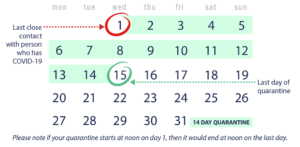With the opening of schools and the re-opening of some businesses – not to mention all of the opportunities that folks had for exposure over this past Labor Day holiday weekend – an uptick in COVID infections may be part of the September forecast. As such, we thought it prudent to revisit some of the CDC guidelines first shared at the beginning of the summer and try to provide some clarification around how to legally apply them now to your workforce.
It’s important to clarify what qualifies as exposure.
The CDC specifies that if you have been within 6 feet of someone for more than 15 minutes during the 48 hours before they are positive, then you have been exposed. For purposes of contact tracing, if an employee (or friend or neighbor) notifies you they have received a positive test result, the question becomes: on what day were you first symptomatic? And then count back two days from the arrival of those symptoms and itemize all individuals who were within 6 feet of the infected person for more than 15 minutes.
If an infected person worked in your office last week in isolation with the door closed, it’s unlikely any of their coworkers were exposed. Similarly, if your neighbor passed by walking his dog and you didn’t stop for a chit chat while the dog did his business, this doesn’t meet the CDC guidelines of exposure.
It’s important to understand the parameters for quarantine.
In the unfortunate circumstance where an employee was in close contact with coworkers for more than 15 minutes in the 48 hours prior to the presentation of symptoms, the CDC does recommend quarantine for 14 days for those exposed individuals from the last time they were exposed to the infected individuals. It’s important to note that if exposure continues for a 7-day period, the recommended 14-day quarantine period starts on day 7, not day 1 of exposure.
It’s important to understand the implications of testing.
 Finally, a negative test does not waive the quarantine period. More plainly said, an exposed employee who received a negative COVID test on day 5 or 10 of their 14-day quarantine period should not be allowed to return to work as the lengthy incubation period of the virus could allow for symptoms not present on day 5 or 10 to present as infection by day 12 or 14.
Finally, a negative test does not waive the quarantine period. More plainly said, an exposed employee who received a negative COVID test on day 5 or 10 of their 14-day quarantine period should not be allowed to return to work as the lengthy incubation period of the virus could allow for symptoms not present on day 5 or 10 to present as infection by day 12 or 14.
